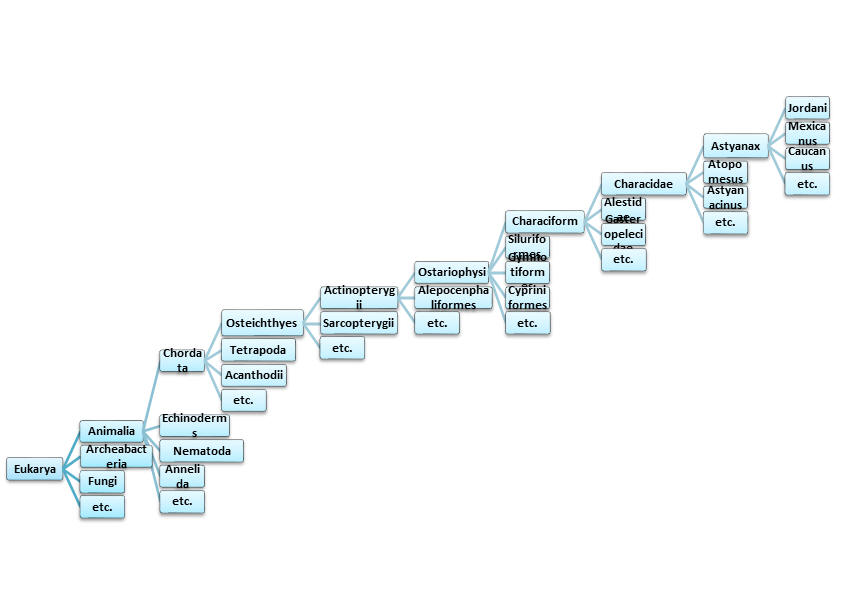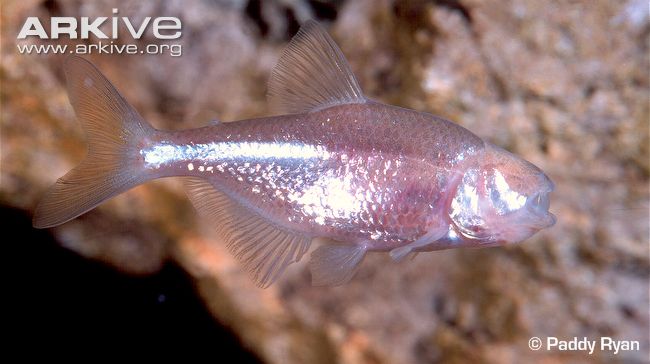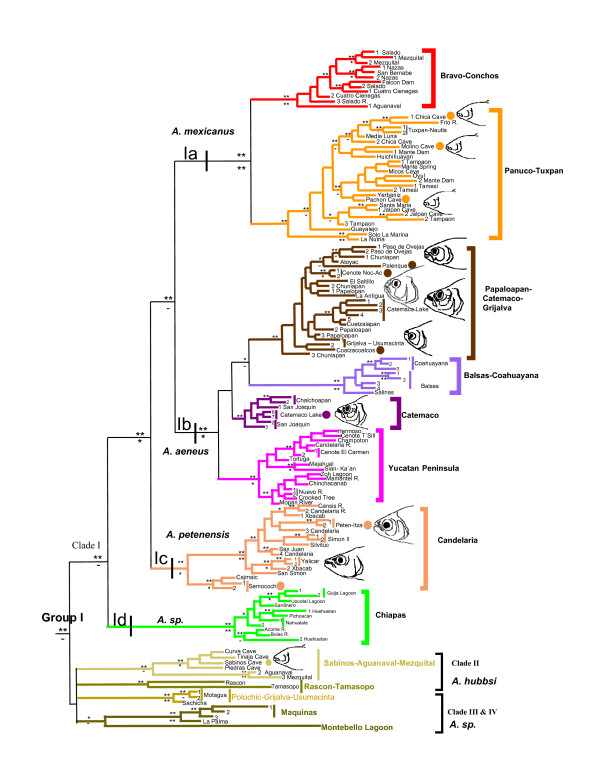Who am I?
Table
1. Characteristics of specific taxonomic levels relating to the
Astyanax jordani.
| Taxon Level | Taxon Name | Characteristic(s) |
| Domain | Eukarya | Membrane bound organelles with a nucleus |
| Kingdom | Animalia | Eukaryote without cell wall |
| Phylum | Chordata | Hollow nerve cord that lies dorsal to notochord |
| Superclass | Osteichthyes | Bony fishes: bone skeleton |
| Class | Actinopterygii | Ray-finned fishes |
| Superorder | Ostariophysi | Weberian Apparatus |
| Order | Characinormes | Possess a small, fleshy adipose fin between dorsal fin and tail |
| Family | Characidae | Freshwater subtropical and tropical tetra fish |
| Genus | Astyanax | Broadly distributed features among the Characidae (no studies that support its monophyly) |
| Species | jordani | "Blind" Cave fish: lack of eye sight (this name sometimes refers to its close relative the Astyanax mexicanus |

Figure 1.
Tree indicating morphological relationships among different taxonomic groups and
their sister phyla. (data taken from eol.org)
Kingdom: Animalia
-This kingdom is comprised of a major group of organisms that
can sometimes be referred to as the Metazoa, along with
Animalia. Characteristics of this group are: multi-cellularity,
eukaryotic, ingesting heterotrophs, possess some type of
skeletal support system, possess levels of cellular, tissue,
organ, and system organization, possess specialized cells for
particular functions, and sexual reproduction.
Phylum: Chordata*
-This phylum of organisms is characterized by four defining
traits.
1. Notochord: this is a
skeletal rod that runs down the dorsal side of an animal that
helps support both embryonic and adult organisms. This notochord
will later develop into the vertebrae.
2. Dorsal Nerve Cord:
this is a hollow cord that is dorsal to the notochord and runs
the length of the body. This same cord is found on the ventral
side of the body cavity is animals that are not part of the
phylum Chordata. This hollow nerve cord branches and spreads to
reach different muscles of the body, connecting them to the
central nervous system.
3. Gill Structures: this
structure is used as a respiratory organ in aquatic animals so
that, for example, a fish can breathe in oxygen that is
dissolved in water.
4. Post-Anal Tail: this
is an extension of the body past the anal opening. This is
sometimes a very obvious feature in animals, for example a dog,
cat, or fish; however, some do not realize that humans also fall
into this category by having a tail at some point in the
embryonic stage.
*(Buchsbaum, Buchsbaum, Pearse and Pearse, 1987) and (North Virginia Community College, 2002)
Superclass: Osteichthyes**
-This superclass (comprised of the Greek words Osteon=bone and
ichthyes=fish) comprises what are known as the bony fishes. This
means that instead of having a cartilaginous skeletal system,
they will have bone. Other characteristics that define this
superclass are the operculum, a flap that is found on each side
of the head that covers the external side of the gills. The
ability to move these flaps helps the fish to breathe without
having to move and consume a lot of energy. The bony fish make
up more than 95% of all fish and half of all species of
invertebrates. Although some of them are herbivores, most bony
fish are carnivorous. Because this superclass contains many
different species of animals, relatives of the Blind Cave Fish
might not seem obvious. For example the Hippocampus kelloggi,
or Great Seahorse, also belongs to this superclass even though
its morphology doesn't resemble the Astyanax jordani.
To see other ways that these organisms are alike and different,
check out the Great Seahorse
HERE.
**(North Virginia Community College, 2002)
Class: Actinopterygii***
-This class, and sometimes sub-class of fishes are made up of
what are called “ray-finned fishes”. This is because they
possess fin rays (lepidotrichia)
meaning that their fins act as webs of skin that are held
together and supported by bones or spines. These boney fin rays
attach directly to the basal or proximal skeletal elements. This
signifies the connection between the internal skeleton and the
fins. Those that are not classified under this group will have
fleshy, lobed fins as opposed to boney ones.
-This class is dominant in the Chordates and is made up of
nearly 95% of the 25,000 species of fish. This class is not
specific to one habitat and can be found throughout marine and
freshwater enviroments at all different levels of the water
column. Along with a diverse habitat, this class is also known
for having a range of sizes, from 8mm to 11meters to 2,300
kilograms. Another fish that belongs to this class is the Bandit
Angelfish. Although lacking many of the same morphological
features that the Angelfish has, it and the A. jordani
both relate by possessing ray-fins. To see this intriguing and
beautiful fish check out its website
HERE.
***(The Virtual Fossil Museum, 2012)
Superorder: Ostariophysi
-This superorder has three defining characteristics within it to
help sort out organisms: auditory specializations of the inner
ear, anterior vertebrae
(Weberian complex), and a gas bladder. (Tree of Life
Web Project, 2005). Auditory specializations can help the fish
when other sensations, like sight, are lost along with helping
buoncacy in the water. (Deng, Wagner, and Popper,
2013). The Weberian Complex is an apparatus that improves
audition by consisting of a double chain of ossicles that helps
connect the air bladder to the inner ear. (Diogo, 2009). Gas
bladders in fish are connected to the auditory section of the
fish and help to maintain buoyancy and also in some specific
species, play a direct role in hearing. This gas-filled sac is
located in the dorsal portion of the body cavity in this
superorder.
Order: Characiformes****
-This order of fish breaks down into 10 families, 237 genera,
and over 1,200 species of fish. We are able to see this group of
fish ranging from North America to Central and South America to
Africa (some fossils found) housing in completely freshwater
groups. These fish possess jaw teeth that are well developed and
possess replacement teeth if needed. Along with that, pharyngeal
teeth are usually present, however, some species do not have
specific specialized teeth. Adipose fin and scales are almost
always present, only in rare occurrences do they not show up
along with commonly absent barbels. Finally, most of the fish
are relatively small bodied and very colorful.
****(SBS Texas BIO 354 Lecture, 2014)
Family: Characidae*****
-This family of fish tends to inhabit tropical frishwaters of
Africa and Southern and Central America. Because this group is
so diverse, it is difficult to state defining characteristics.
Their length can range from 3cm to 100cm, they are seen in many
different colors and patterns, and tend to physically be grouped
in different “common names” such as: tetras, pirahnas, etc. This
shows that their diet is also non-exclusive to this family; some
tend to be fierce predators while others have been seen to eat
fruit that has fallen from a tree in the rainforest.
*****(Characidae, 2011)
Genus: Astyanax
-This genus of fish is a great group of species being studied in
the biological field at this time and is thought to be an ideal
model to investigate the importance of a geographical separation
of a population resulting in groups of closely related species
versus the distribution of habitats biogeographically. This is
because this genus of fish inhabits a wide array of areas and
levels in the water column and also because its movement is
controlled by freshwater routes in a tropical area, which are
surrounded by marine oceans. This genus makes up over 107
recognized species and helps comprise (with
Hyphesobrycon) the largest and most diverse
Characiform species. (Ornelas-García, Domínguez-Domínguez, and Doadrio, 2008).

Species: jordani
-This species of fish is said to have evolved from the
Astyanax mexicanus, which is a close relative that inhabits
the surface of water instead of the bottom of the water column.
This species of fish is known for its habitat in cave areas
where it is least vulnerable for being blind and having no
pigmentation. Melanin pigmentation helps to protect an animal
from UV light generally, however, with this fish living in dark
spaces all the time, pigmentation is not necessary for survival.
(Bilandzija, Li-Ma, Parkhurst, and
Jeffery, 2013).
-Both the Astyanax jordani and the Astyanax
mexicanus have taste buds that are ultra sensitive and
highly formed. They are found to have three types of taste buds
that are elevated at different levels along with taste buds
appearing in the epithelia of the lips, oral cavity, and also in
the lower jaw. (Boudriot and Reutter, 2001).
F
Go back home!
Now that you know all about the family tree of the A.
jordani check out where it lives HERE!
Want to see other organisms created by UWL students:
Check out
MultipleOrganisms.net!
